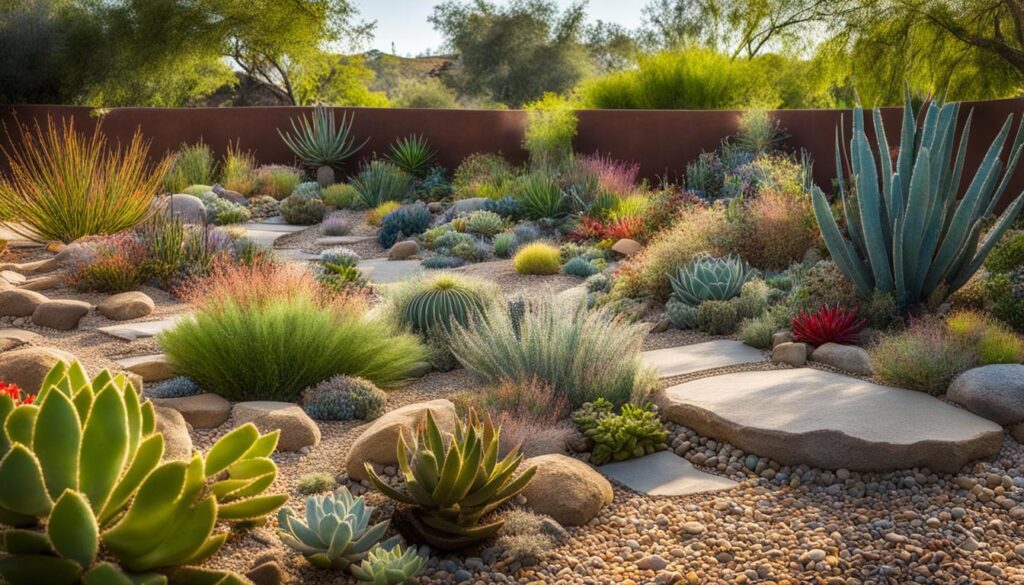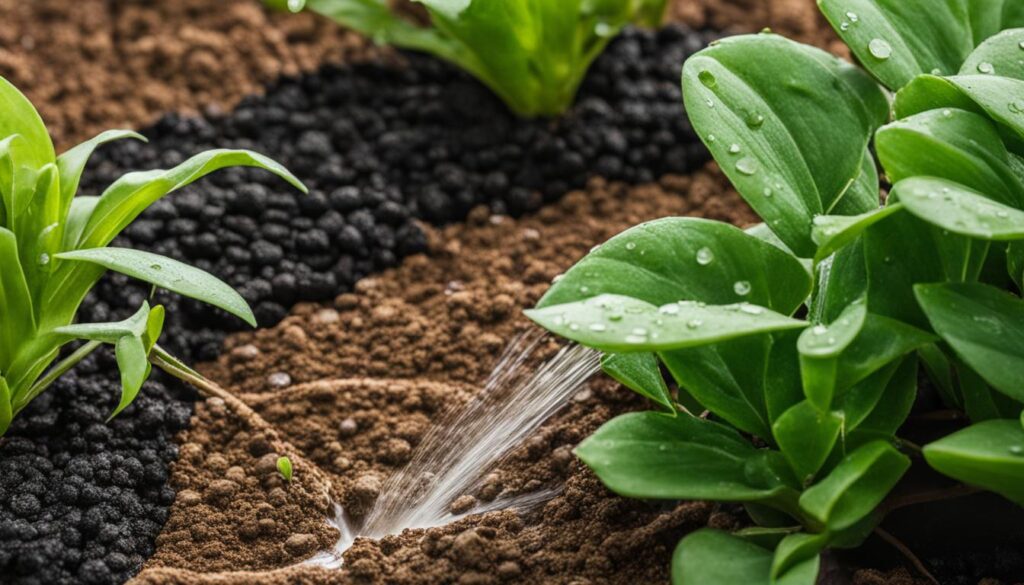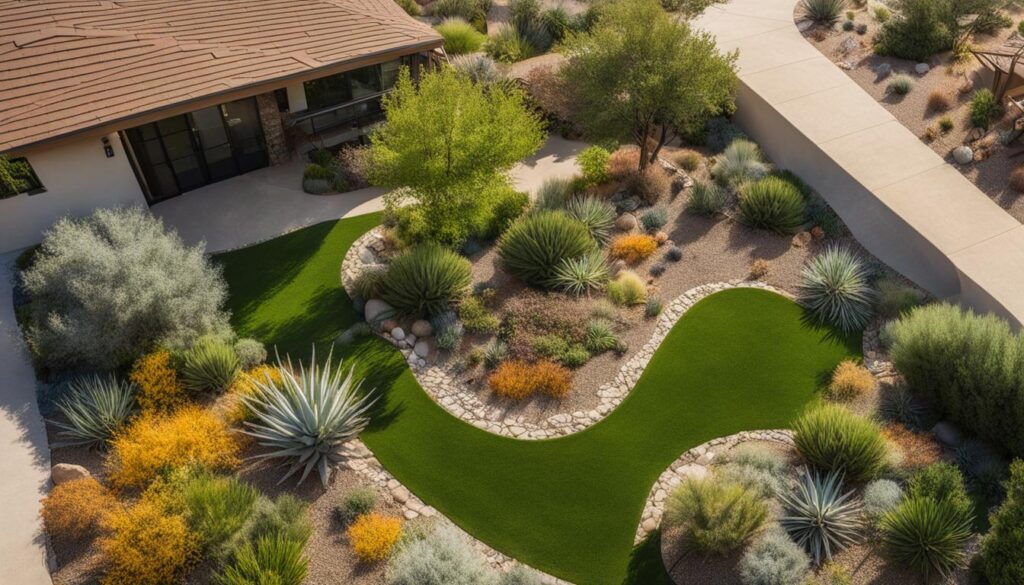Are you looking to create a stunning garden while conserving water? Xeriscape gardening is the perfect solution for you. In this guide, we will show you how to start a xeriscape garden in the United States, regardless of your climate. By implementing water-wise techniques and choosing drought-tolerant plants, you can create a beautiful and sustainable landscape that thrives with minimal water. Let’s dive in!
Key Takeaways:
- Xeriscape gardening is a water-conservation technique suitable for areas prone to drought or where water conservation is practiced.
- By grouping plants based on their water needs, using mulch, and choosing drought-tolerant plants, you can create a water-wise garden that requires less maintenance.
- Understanding the principles of xeriscape landscaping, such as planning based on topography and incorporating native plants, is crucial for success.
- Selecting drought-tolerant plants that are well-adapted to your region will ensure your xeriscape garden thrives.
- Efficient irrigation methods, such as drip irrigation, help deliver water directly to the roots of plants, reducing water waste.
Understanding the Principles of Xeriscape Landscaping
Xeriscape landscaping is a sustainable gardening approach that aims to create a water-wise garden. By following several principles, you can design a landscape that not only conserves water but also thrives with minimal irrigation. These principles focus on optimizing your garden’s layout, selecting drought-tolerant plants, and implementing efficient irrigation methods.
Planning the Garden
When planning your xeriscape garden, consider the topography, exposure, and soil conditions of your site. This will help you determine the appropriate placement of plants and optimize water usage. Grouping plants with similar water requirements together will ensure efficient irrigation and prevent over-watering. Additionally, incorporating native plants that are adapted to the local climate will reduce water needs and promote a thriving garden.
Choosing Drought-Tolerant Plants
Selecting plants that are well-suited for drought conditions is essential in xeriscape landscaping. Drought-tolerant plants, also known as xeric plants, have low water requirements and can thrive with minimal irrigation. Consider incorporating plants like coneflowers, lavender, sedum, and coreopsis, which are known for their ability to withstand dry spells. Grouping plants with similar water needs together will optimize water usage and prevent over-watering.
Implementing Efficient Irrigation
Efficient irrigation is key to maintaining a water-wise garden. Drip irrigation is a recommended method as it delivers water directly to the roots, minimizing water waste. This system allows for precise control over the amount and timing of water delivery, reducing the risk of over-watering. It’s important to adjust the watering schedule based on the specific needs of your plants and to promote healthy root development by ensuring well-draining soil.
By understanding the principles of xeriscape landscaping and implementing them in your garden, you can create a beautiful and environmentally sustainable landscape. Planning your garden layout, selecting drought-tolerant plants, and using efficient irrigation methods will help you conserve water and promote the growth of a thriving water-wise garden.
Selecting Drought-Tolerant Plants for a Xeriscape Garden
When creating a xeriscape garden, one of the key considerations is selecting the right plants that can thrive in drought conditions. These plants, often referred to as drought-tolerant or xeric plants, have low water requirements and can survive with minimal irrigation. By choosing the right plants for your xeriscape garden, you can ensure that your garden remains lush and vibrant while conserving water.
One approach to selecting drought-tolerant plants is to incorporate native species that are naturally adapted to the local climate. Native plants have evolved to survive in the specific conditions of your region and usually require less water to thrive. Some examples of native drought-tolerant plants in the United States include coneflowers, lavender, sedum, and coreopsis. These plants not only add beauty to your garden but also support local wildlife and ecosystems.
Grouping plants based on their water needs is another important aspect of xeriscape gardening. By clustering plants with similar water requirements together, you can optimize water usage and prevent over-watering. This approach ensures that each plant receives the appropriate amount of water it needs to thrive, without wasting valuable resources.
When selecting drought-tolerant plants for your xeriscape garden, it’s also worth considering their aesthetic appeal and compatibility with other plants in your design. Look for a variety of colors, textures, and heights to create visual interest and a balanced composition. By carefully choosing your plant selection, you can create a stunning xeriscape garden that conserves water and enhances your outdoor space.
Benefits of selecting drought-tolerant plants for a xeriscape garden
- Conserves water: Drought-tolerant plants require minimal irrigation, helping to reduce water consumption in your garden.
- Low maintenance: These plants are adapted to survive with less water, making them ideal for busy homeowners or those looking to reduce the time and effort spent on garden maintenance.
- Thrives in drought conditions: Drought-tolerant plants are resilient and can withstand drought conditions, ensuring that your garden remains beautiful even during dry spells.
- Supports local ecosystems: By incorporating native drought-tolerant plants, you can provide food and habitat for local wildlife, including birds, butterflies, and pollinators.
- Diverse aesthetics: Drought-tolerant plants come in various shapes, sizes, and colors, allowing you to create a visually appealing garden that suits your personal preferences.
Implementing Efficient Irrigation in a Xeriscape Garden
Proper irrigation is crucial when it comes to maintaining a xeriscape garden that thrives while minimizing water waste. One recommended method for efficient irrigation in a xeriscape garden is drip irrigation. This system delivers water directly to the roots of plants, ensuring precise control over the amount and timing of water delivery, reducing the risk of over-watering.
“Drip irrigation is a game-changer for xeriscape gardens. It allows you to provide water exactly where it is needed, without wasting a drop,” says horticultural specialist, Sarah Greenway.
In a xeriscape garden, it is important to base the watering schedule on the specific needs of the plants and adjust accordingly during the establishment phase. While supplemental watering may be required initially, the frequency of watering should decrease as plants become established. This approach not only conserves water but also encourages the development of deep root systems, making the plants more resilient to drought conditions.
Additionally, well-draining soil is crucial in a xeriscape garden as it promotes healthy root development and minimizes the need for supplemental water. Improving soil drainage can be achieved by incorporating organic matter, such as compost, into the soil. This helps loosen compacted soil and enhances its water-holding capacity.
Benefits of Efficient Irrigation:
- Minimizes water waste and promotes water conservation
- Reduces the risk of over-watering and related plant diseases
- Encourages deep root growth and drought tolerance
- Saves time and effort in garden maintenance
By implementing efficient irrigation methods such as drip irrigation and optimizing soil drainage, you can ensure that your xeriscape garden receives the right amount of water while minimizing water waste. This not only benefits the environment but also promotes the health and vitality of your plants.
Designing a Xeriscape Garden Layout
Creating a well-designed layout is crucial when designing a xeriscape garden. By considering factors such as site topography, sun exposure, and soil conditions, you can maximize the efficiency of your water-wise garden. One important aspect of the layout is to create distinct planting zones based on the water needs of different plants. This allows you to optimize water usage and ensure that each plant receives the appropriate amount of water.
Incorporating hardscapes, such as pathways and patios, can add visual interest to your xeriscape garden while reducing the need for water-intensive lawn areas. By replacing or reducing the size of your lawn, you can create more space for drought-tolerant plants and reduce overall water consumption. Additionally, consider integrating rock gardens and flower beds, which require less water and maintenance compared to traditional grass lawns.
When selecting plants for your xeriscape garden, pay attention to their sun and shade preferences. Placing plants that require full sun in areas with maximum sun exposure, and those that prefer partial shade in areas with some shade, will optimize their growth and water usage. Be sure to group plants with similar water requirements together to streamline your irrigation efforts and prevent over-watering.
Key Points for Designing a Xeriscape Garden Layout:
- Create distinct planting zones based on water needs.
- Incorporate hardscapes to replace or reduce lawn areas.
- Integrate rock gardens and flower beds for low-maintenance alternatives.
- Consider sun and shade preferences when placing plants.
- Group plants with similar water requirements together.
Designing a xeriscape garden requires careful planning and consideration of various factors. By implementing these design principles, you can create a visually appealing and water-wise garden that is both sustainable and low-maintenance.
Can I Use the DIY Xeriscape Garden Care Guide to Start a Xeriscape Garden in the United States?
Yes, you can use the DIY Xeriscape Garden Care Guide to start a xeriscape garden in the United States. The xeriscape garden care tips provided in the guide are applicable in various regions, and can help you create a sustainable and water-efficient garden in the US.
Maintaining a Xeriscape Garden
Once you have created your xeriscape garden, it is important to provide regular care and maintenance to ensure its continued health and beauty. While xeriscape gardens are designed to be low-maintenance, they still require some attention to keep them thriving. Here are some essential tips for maintaining your xeriscape garden:
- Remove weeds regularly: Weeds can compete with your drought-tolerant plants for water and nutrients, so it’s important to remove them as soon as you spot them. Regular weeding will help keep your xeriscape garden free from unwanted plants and ensure that your chosen plants can thrive.
- Prune and deadhead: Pruning is important to maintain the shape and size of your plants while deadheading helps encourage continuous blooming. Trim back any overgrown branches or spent flowers to keep your garden looking neat and encourage healthy growth.
- Monitor irrigation: While xeriscape gardens require minimal watering, it is important to monitor your irrigation system to ensure efficient water usage. Check for any leaks or clogs and adjust the watering schedule as needed. Remember, the goal is to provide just enough water for your plants to thrive without wasting any.
With proper care and attention, your xeriscape garden will continue to flourish and provide a beautiful, water-wise landscape for years to come. Regular maintenance will help preserve the health and longevity of your plants and ensure that your garden remains a vibrant oasis.
Quote:
“Regular weeding, pruning, and monitoring of irrigation are essential for maintaining a healthy xeriscape garden.”
Conclusion
Now that you have reached the end of this xeriscape gardening guide, you are equipped with the knowledge and principles to create a water-wise and sustainable landscape. By adopting xeriscape techniques, you become an active participant in water conservation efforts while still having a beautiful garden to enjoy.
The focus on drought-tolerant plants, efficient irrigation methods such as drip irrigation, and careful garden layout design will help you minimize water usage and create a visually appealing and functional space. This approach not only reduces maintenance requirements but also contributes to a more sustainable future.
Embrace xeriscape gardening as a way to conserve water and promote sustainable landscaping practices. By following the guidelines outlined in this guide, you can play a role in preserving this valuable resource and creating an environment that thrives even in drought conditions. Start your xeriscape garden journey and be a part of the solution for a more sustainable future.














